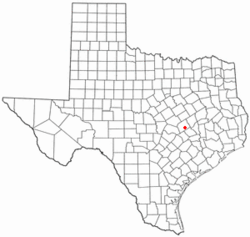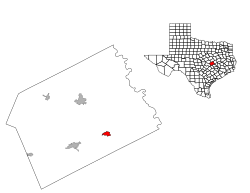Milano, Texas facts for kids
Quick facts for kids
Milano, Texas
|
|
|---|---|

Location of Milano, Texas
|
|
 |
|
| Country | |
| State | |
| County | Milam |
| Area | |
| • Total | 1.83 sq mi (4.74 km2) |
| • Land | 1.83 sq mi (4.73 km2) |
| • Water | 0.00 sq mi (0.01 km2) |
| Elevation | 522 ft (159 m) |
| Population
(2020)
|
|
| • Total | 390 |
| • Density | 230.43/sq mi (88.96/km2) |
| Time zone | UTC-6 (CST) |
| • Summer (DST) | UTC-5 (CDT) |
| ZIP code |
76556
|
| Area code(s) | 512, 737 |
| FIPS code | 48-48336 |
| GNIS feature ID | 1362829 |
Milano is a small town in Milam County, Texas, United States. It is located where U.S. Route 79 and State Highway 36 meet. Milano is about twelve miles southeast of Cameron, which is the main city of the county. In 2020, about 390 people lived there.
Where is Milano?
Milano is located at coordinates 30.709190 degrees North and 96.863420 degrees West.
The United States Census Bureau says the town covers about 2.0 square miles (5.2 square kilometers). Most of this area is land. Only a very small part, about 0.51%, is water.
Milano's History
The International-Great Northern Railroad Company first planned the town of Milano in 1874. This was about a mile and a half west of where the town is today. A United States post office opened there in the same year. Soon after, a Baptist church was also built. By 1880, the community around Milano became a place where people could vote.
There are a few ideas about how Milano got its name. One story says it was named after Milan, Italy. People thought the climates were similar, but Milan in Italy is actually much colder. Another idea is that the name was supposed to be "Milam." However, the United States Post Office Department might have made a mistake or changed it on purpose. This could be because another town named Milam, Texas, already existed.
In 1881, the Gulf, Colorado and Santa Fe Railroad Company built a new railway line. This line crossed the International-Great Northern railway about two miles east of Milano. A new town called Milano Junction grew up at this crossing. Over time, people moved to the new town. The original Milano became known as "Old Milano," and Milano Junction became the new Milano.
By the late 1880s, Milano was a busy place. It had about 500 residents. The town was a shipping center for cotton and animal hides from the area. In the 1920s, truck farming became very important. Farmers grew and shipped crops like tomatoes, watermelon, and cantaloupes.
Milano's population was largest in 1939, with about 920 people living there. The number of residents started to go down in the 1940s. By the early 1970s, only about 380 people lived in Milano. But then, in the late 1970s, the population started to grow again. Milano officially became an incorporated city in the early 1980s, with 468 residents.
Milano's Population
| Historical population | |||
|---|---|---|---|
| Census | Pop. | %± | |
| 1980 | 468 | — | |
| 1990 | 408 | −12.8% | |
| 2000 | 400 | −2.0% | |
| 2010 | 428 | 7.0% | |
| 2020 | 390 | −8.9% | |
| U.S. Decennial Census | |||
The population of Milano has changed over the years. Here's a quick look at how many people lived there during different census years:
- In 1980, there were 468 people.
- In 1990, the population was 408.
- In 2000, it was 400.
- In 2010, it grew slightly to 428.
- By 2020, the population was 390.
In 2020, there were 390 people living in Milano. These people lived in 229 households, and 174 of these were families.
Back in 2000, there were 400 people and 151 households. About 36.4% of households had children under 18. Many households (53.6%) were married couples. About 23.2% of households were single people living alone. The average household had 2.65 people.
Education in Milano
The Milano Independent School District serves the students in Milano. This district has schools for all age groups:
- Milano Elementary School: For students in Pre-Kindergarten through 5th grade.
- Milano Junior High School: For students in 6th through 8th grade.
- Milano High School: For students in 9th through 12th grade.
See also
 In Spanish: Milano (Texas) para niños
In Spanish: Milano (Texas) para niños


